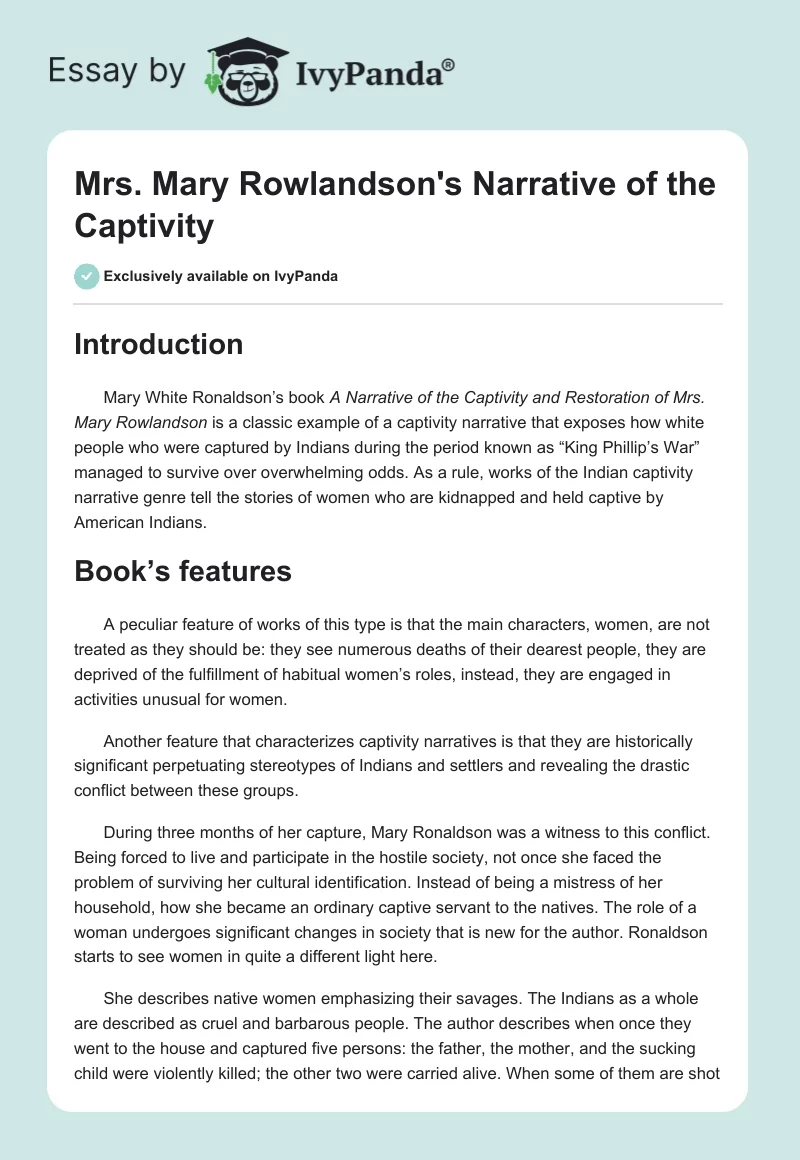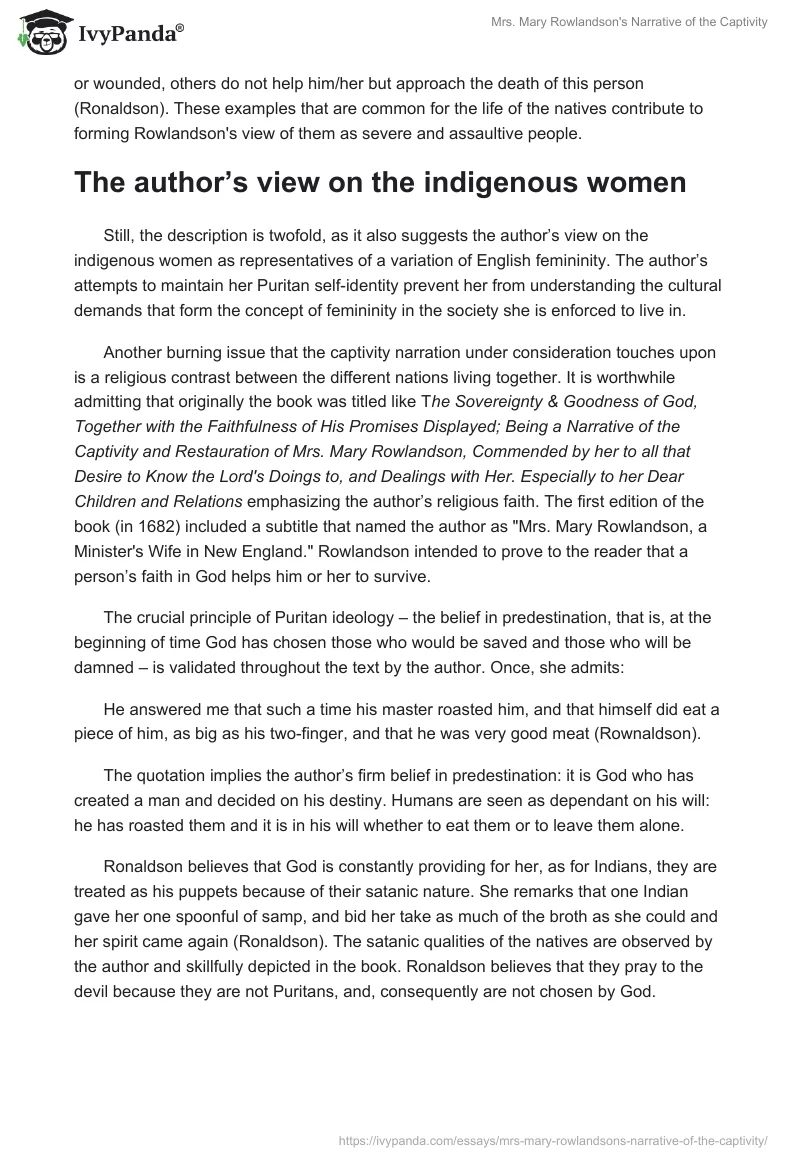Introduction
Mary White Ronaldson’s book A Narrative of the Captivity and Restoration of Mrs. Mary Rowlandson is a classic example of a captivity narrative that exposes how white people who were captured by Indians during the period known as “King Phillip’s War” managed to survive over overwhelming odds. As a rule, works of the Indian captivity narrative genre tell the stories of women who are kidnapped and held captive by American Indians.
Book’s features
A peculiar feature of works of this type is that the main characters, women, are not treated as they should be: they see numerous deaths of their dearest people, they are deprived of the fulfillment of habitual women’s roles, instead, they are engaged in activities unusual for women.
Another feature that characterizes captivity narratives is that they are historically significant perpetuating stereotypes of Indians and settlers and revealing the drastic conflict between these groups.
During three months of her capture, Mary Ronaldson was a witness to this conflict. Being forced to live and participate in the hostile society, not once she faced the problem of surviving her cultural identification. Instead of being a mistress of her household, how she became an ordinary captive servant to the natives. The role of a woman undergoes significant changes in society that is new for the author. Ronaldson starts to see women in quite a different light here.
She describes native women emphasizing their savages. The Indians as a whole are described as cruel and barbarous people. The author describes when once they went to the house and captured five persons: the father, the mother, and the sucking child were violently killed; the other two were carried alive. When some of them are shot or wounded, others do not help him/her but approach the death of this person (Ronaldson). These examples that are common for the life of the natives contribute to forming Rowlandson’s view of them as severe and assaultive people.
The author’s view on the indigenous women
Still, the description is twofold, as it also suggests the author’s view on the indigenous women as representatives of a variation of English femininity. The author’s attempts to maintain her Puritan self-identity prevent her from understanding the cultural demands that form the concept of femininity in the society she is enforced to live in.
Another burning issue that the captivity narration under consideration touches upon is a religious contrast between the different nations living together. It is worthwhile admitting that originally the book was titled like The Sovereignty & Goodness of God, Together with the Faithfulness of His Promises Displayed; Being a Narrative of the Captivity and Restauration of Mrs. Mary Rowlandson, Commended by her to all that Desire to Know the Lord’s Doings to, and Dealings with Her. Especially to her Dear Children and Relations emphasizing the author’s religious faith. The first edition of the book (in 1682) included a subtitle that named the author as “Mrs. Mary Rowlandson, a Minister’s Wife in New England.” Rowlandson intended to prove to the reader that a person’s faith in God helps him or her to survive.
The crucial principle of Puritan ideology – the belief in predestination, that is, at the beginning of time God has chosen those who would be saved and those who will be damned – is validated throughout the text by the author. Once, she admits:
He answered me that such a time his master roasted him, and that himself did eat a piece of him, as big as his two-finger, and that he was very good meat (Rownaldson).
The quotation implies the author’s firm belief in predestination: it is God who has created a man and decided on his destiny. Humans are seen as dependant on his will: he has roasted them and it is in his will whether to eat them or to leave them alone.
Ronaldson believes that God is constantly providing for her, as for Indians, they are treated as his puppets because of their satanic nature. She remarks that one Indian gave her one spoonful of samp, and bid her take as much of the broth as she could and her spirit came again (Ronaldson). The satanic qualities of the natives are observed by the author and skillfully depicted in the book. Ronaldson believes that they pray to the devil because they are not Puritans, and, consequently are not chosen by God.
Conclusion
Rowlandson’s narrative appeared during the late seventeenth century, this was the time when discourses of racial differences were gaining the form the contemporary world is suffering from. Prejudices, presuppositions of one nation towards another are immoral no matter in what form they appear. In the case described above the stereotypes that the character had as far as the life of the American Indians is concerned were sustained by her religious beliefs.
When religion helps to maintain the stereotypical way of thinking that cannot lead to anything good, it loses its majestic power of purification of the believer, and, on the contrary, it fills him or her with unreasonable anger and even hatred. As Rowlandson did not realize the poisonous power of the stereotypes she had towards the natives, this prevented her from living a more happy life than she had. The book serves as an example of how people should treat others for adequate understanding them and for being adequately understood themselves.
References
Ronaldson, Mary white. A Narrative of the Captivity and Restoration of Mrs. Mary Rowlandson. Web.
Toulouse, Teresa A. “‘American Puritanism’ and Mary White Rowlandson’s Narrative.” Challenging Boundaries: Gender and Periodization. Ed. Joyce W. Warren and Margaret Dickie. Athens, GA: U of Georgia P, 2000: 137-58.
Wesley, Marilyn C. “Moving Targets: The Travel Text in A Narrative of the Capitivity and Restauration of Mrs. Mary Rowlandson.” Essays in Literature 23.1 (1996): 42-57.


